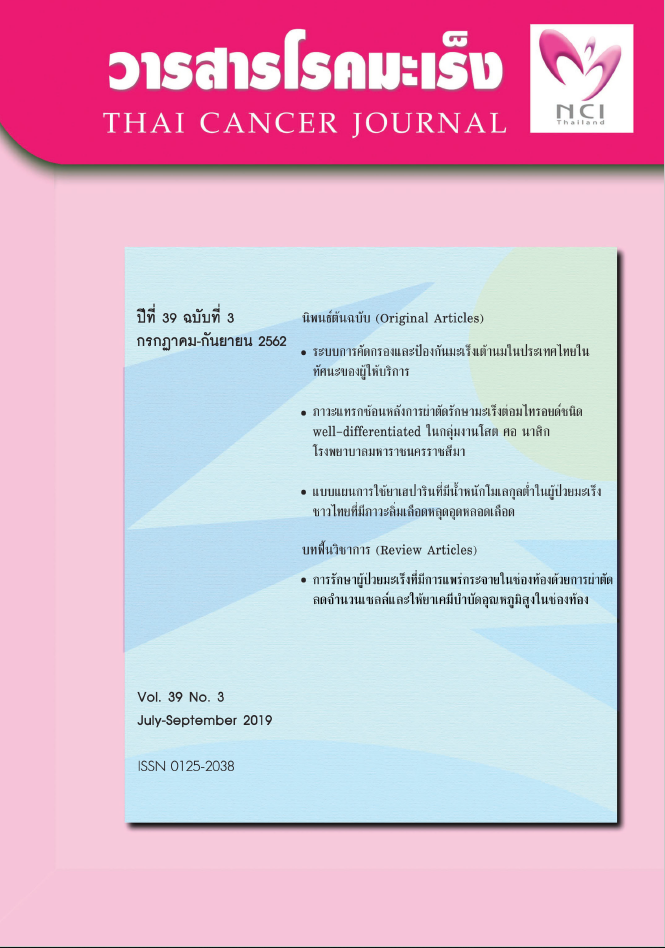Patterns of Low Molecular Weight Heparin Dosage Regimen in Thai Cancer Patients with Venous Thromboembolism
Abstract
Cancer patients with venous thromboembolism (VTE) have a 2-6 times higher mortality rate than those without VTE. Low molecular weight heparin (LMWH) is the drug of choice for the treatment of VTE in cancer patients. Enoxaparin is the LMWH most often prescribed for VTE in Thai cancer patients. NCCN and ASCO recommend enoxaparin at a dose of 1 mg/kg subcutaneously twice daily or 1.5 mg/kg once a day, with dose adjustment according to renal function. However, in clinical practice, there are many patterns of use for enoxaparin for VTE in Thai cancer patients. This study aimed to explore the patterns of use for LMWH for VTE treatment among patients with cancer. We conducted a retrospective chart review of cancer patients with VTE who had received LMWH at King Chulalongkorn Memorial hospital between January 2014 and February 2019; the relevant data of 140 cancer patients were collected and reviewed . Most of the patients were female (59%) and the average age was 60 + 15 years. The most common cancer was lung cancer (33.6%) and most of the patients were in the advanced stage (85.7%). Deep vein thrombosis (DVT) was most common type of VTE found (51%). All patients were prescribed enoxaparin with optimal dose (50%). However, 45% of the cancer patients received enoxaparin at a subtherapeutic dose and 5% received enoxaparin in a supratherapeutic dose. At 3 months' follow-up, 72.9% and 71.4% of cancer patients had undergone efficacy evaluation by clinical assessment or venous radio-imaging, respectively. Adverse effects (bleeding) were found among 11%. Cancer patients who received supratherapeutic doses had significantly more bleeding (57%) than the optimal dose (8.6%) or subtherapeutic dose (9.5%) (P=0.000). In conclusion, most of the cancer patients with VTE received LMWH at the optimal dose and underwent clinical-symptom assessment and venous radio-imaging. Supratherapeutic doses of enoxaparin were associated with increased bleeding.
References
Arklel YS. Thrombosis and cancer. Semin Oncol 2000;27:362-74.
Trousseau A. Phlegmasia alba dolens. Clinique Medicale de l’ hotel-dieu de Paris. London: New Sydenham Society, 1865;3:94.
Blom JW, Doggen CJ, Osanto S, Rosendaal FR. Malignancies, prothrombotic mutations, and the risk of venous thrombosis. JAMA 2005;293:715-22.
SØrensen HT, Mellemkjaer L, Olsen JH, Baron JA. Prognosis of cancers associated with venous thromboembolism. N Engl J Med 2000;343:1846-50.
Khorana AA, Francis CW, Culakova E, Kuderer NM, Lyman GH. Thromboembolism is a leading cause of death in cancer patients receiving outpatient chemotherapy. J Thromb Haemost 2007;5:632-4.
ฉัตรวดี ลิ้มไพบูลย์, กมลวรรณ จึงมีโชค, ศุภขจี แสงเรืองอ่อน. การศึกษาความชุกของภาวะหลอดเลอืดแดงปอดอุดตันจากลิ่มเลือดในผู้ป่วยที่เป็นโรคมะเร็ง โดยใช้เครื่องเอกซเรย์คอมพิวเตอร์ความเร็วสูง 64 สไลซข์องช่องอก ณ โรงพยาบาลพระมงกุฎเกล้า. เวชสารแพทย์ทหารบก 2554;64:19-27.
Mutirangura, P, Rüengsethakit, C, Wongwanit, C. Epidemiologic analysis of proximal deep vein thrombosis in Thai patients: malignancy, the predominant etiologic factor. Int J Angiol 2004;13:81-3.
National Comprehensive Cancer Network. CancerAssociated Venous Thromboembolic Disease (Version 1.2014). Available at: http://williams.medicine. wisc.edu/vtecancer.pdf. Accessed April 12, 2018.
Lee AY, Levine MN, Baker RI, Bowden C, Kakkar AK, Prins M, et al. Low-molecular-weight heparin versus a coumarin for the prevention of recurrent venous thromboembolism in patients with cancer. N Engl J Med 2003;349:146-53.
Donnellan E, Kevane B, Bird BR, Ainle FN. Cancer and venous thromboembolic disease: from molecular mechanisms to clinical management. Curr Oncol 2014;21:134-43.
De Martino RR, Goodney PP, Spangler EL, Wallaert JB, Corriere MA, Rzucidlo EM, et al. Variation in thromboembolic complications among patients undergoing commonly performed cancer operations. J Vasc Surg 2012;55:1035-40.
KrÖger K, Weiland D, Ose C, Neumann N, Weiss S, Hirsch C, et al. Risk factors for venous thromboembolic events in cancer patients. Ann Oncol 2006;17:297-303.
Khorana AA, Carrier M, Garcia DA, Lee AY. Guidance for the prevention and treatment of cancer-associated venous thromboembolism. J Thromb Thrombolysis 2016;41:81-91.
Meyer G, Marjanovic Z, Valcke J, Lorcerie B, Gruel Y, Solal-Celigny P, et al. Comparison of low-molecular-weight heparin and warfarin for the secondary prevention of venous thromboembolism in pa-tients with cancer: a randomized controlled study. Arch Intern Med 2002;162:1729-35.
Deitcher SR, Kessler CM, Merli G, Rigas JR, Lyons RM, Fareed J; ONCENOX Investigators. Secondary prevention of venous thromboembolic events in patients with active cancer: enoxaparin alone versus initial enoxaparin followed by warfarin for a 180-day period. Clin Appl Thromb Hemost 2006;12:389-96.
Downloads
Published
Issue
Section
License
บทความทีตีพิมพ์ในวารสารโรคมะเร็งนี้ถือว่าเป็นลิขสิทธิ์ของมูลนิธิสถาบันมะเร็งแห่งชาติ และผลงานวิชาการหรือวิจัยของคณะผู้เขียน ไม่ใช่ความคิดเห็นของบรรณาธิการหรือผู้จัดทํา






